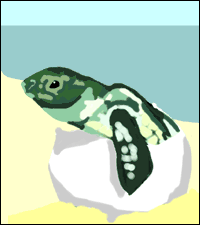Loggerhead Sea Turtles
Created | Updated Oct 12, 2015

The sea turtle, named Caretta caretta by the scientific community, is popularly referred to as the loggerhead turtle, due to the creature's heavy and large head. As a young creature, the turtle's reddish-brown shell is five centimetres or so long. Maturity can be reached by about four years old, but generally takes longer - some sea turtles take until the middle of their lives to mature. Although it is unknown how long they live, it's estimated to be around 50-100 years. As an adult turtle, they tend to weigh an impressive 90-135 kg and their shells grow to about 90 to 110 cm long.
The loggerhead has large, long flippers that help it manoeuvre through water. Although they are pretty slow swimmers normally, they can use their flippers as an advantage to swim much more quickly when they are threatened. They have also adapted to their lives in the ocean over time by developing a special gland to drink saltwater.
The sea turtles live in temperate water, usually near beaches. Their natural predators are whales and sharks, though of course - as is the case with most turtles - humans are the biggest threat to them. As a result of this, they have been placed on the USA's Federal Fish and Wildlife Endangered Species list.
Mating and Nesting
When nesting season comes, males and females meet to conduct the mating rituals offshore. Little is known to scientists about loggerhead mating. The female stores the sperm of the male all season, making it possible for her to nest up to four times.
The loggerheads lay between 100 and 150 ping-pong ball-sized eggs, (usually around 120 eggs) at night on sandy beaches1 by essentially nesting - making a hole (with their long flippers) to hold the eggs until they hatch. They usually return to the beach where they were born and most loggerheads lay their eggs during summer months. Thousands of the remaining loggerheads return to the same sandy Ocean Isle Beach semi-annually. Ocean Isle Beach in North Carolina2 is a protected beach for the turtles to lay eggs at. In fact, The Turtle Watch programme of Ocean Isle has been formed to protect the eggs. Their hope is to eventually expand the loggerhead population to such an extent that eventually they may be removed from the endangered species list.
The eggs usually stay in the hole for about 65 days, but few survive - in fact it's estimated that one in 10,000 lives to maturity. Most eggs are destroyed by erosion, people, carnivores, loss of heat3 and many other factors. The young loggerheads use the moon to guide them to the ocean. If they are having trouble, volunteers assist hatchlings to get into the water's safety4.
Diet
Loggerheads are omnivores and feed on invertebrates. They are known to eat jellyfish, molluscs, crabs and shrimp as well as several varieties of sea plants. Sometimes they scavenge dead fish, but generally stick to invertebrates.
Habitat
Some loggerheads live in muddy bottom bays in the northern Gulf Coast. Others live in clear, tropical waters. It is unclear why.

